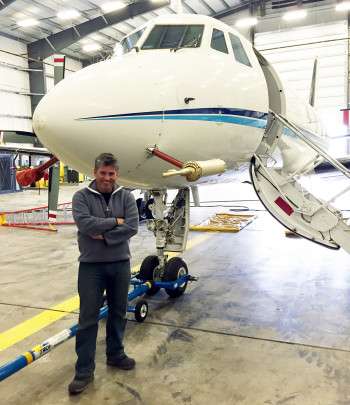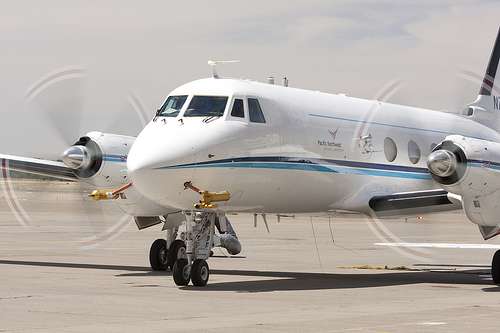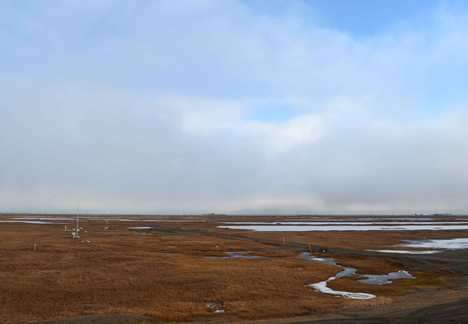Researchers run aerial campaign over Alaska to understand warming trend

A group of scientists from the Atmospheric Measurement Research (ARM) Climate Research Facility won't be looking for gold or oil this summer as they crisscross Alaska's North Slope in an airplane. Instead, the ARM Airborne Carbon Measurements V (ARM-ACME V) team—led by Sebastien Biraud from U.S. Department of Energy's (DOE) Lawrence Berkeley National Laboratory—will run an aerial campaign from June 1 to September 15, measuring trace gas concentrations, aerosols, and cloud properties to find out why current climate models underestimate how rapidly the Arctic is getting warmer.
Using the ARM Aerial Facility's (AAF) Gulfstream-159 (G-1)research aircraft, the team will fly three possible flight paths between Prudhoe Bay, Oliktok Point, Barrow, Atqasuk, Ivotuk, and Toolik Lake measuring carbon dioxide, methane, and carbon monoxide—also known as trace gases—using two different types of gas analyzers and collecting air samples of trace gases with a 12-flask sampler. The aircraft payload also provides measurements of aerosol and cloud properties, atmospheric thermodynamics, and solar/infrared radiation.
Since arctic clouds are known to exert a significant influence on atmospheric radiation and may play a role in observed arctic warming, the ARM-ACME V campaign will also address populations of liquid droplets and ice crystals to help characterize the properties of cloud layers. Measuring aerosol concentration and radiation will help scientists examine how clouds and aerosols interact with each other and with different layers of arctic air.
This research will also link missions supported by multiple federal agencies, like the National Aeronautics and Space Administration (NASA) Carbon in Arctic Reservoirs Vulnerability Experiment missions and the DOE Next-Generation Ecosystem Experiment Arctic project, according to Biraud.
Improving estimates for emission sources

By characterizing atmospheric gas mixing ratios (volume of gas per volume of air) across the North Slope, scientists hope to improve the estimates of the volume of gases like carbon dioxide and methane being emitted from biological sources such as Alaska's permafrost layer which stores large amounts of carbon. Permafrost is thawing at an accelerated pace due to rising air temperature and this degradation releases carbon dioxide and methane—two greenhouse gases that affect the amount of radiant energy that can reach or leave the Earth. Scientists will also use soot spectroscopy observations to fine-tune their understanding of how heat-producing activities, such as biomass burning and oil and gas production, contribute to Arctic warming.
"Warming has two effects," according to Margaret Torn, co-principal investigator for the ARM-ACME V campaign. "As arctic tundra thaws, organic matter decomposes, releasing carbon dioxide and methane, two greenhouse gases. At the same time, the warming trend has a greening effect on Alaska that you can see from space. The additional photosynthesis occurring as a result of this greening takes carbon dioxide out of the atmosphere. We want to determine when one effect is more important than the other—and why."
"These flights will also be looking at surface properties like albedo, which is the amount of solar radiation reflected by the Earth," Torn added. "When solar energy is reflected back into space, it reduces the amount of energy that is available to influence atmospheric convection and gas mixing. That affects the weather."
The ARM-ACME V campaign will also collect more detailed data on the distribution of aerosols that scientists can use to test the accuracy of climate simulation models. One goal is to learn more about the roles played by black and brown carbon in changing the balance between incoming energy from the sun and outgoing energy from the earth.

The G-1 research aircraft will be based at the airport in Deadhorse, Alaska, just outside Prudhoe Bay. During the 15-week campaign, 16 team members will rotate in and out of Alaska in shifts of five for no longer than three weeks at a time. The team will make two or three four-hour flights per week, for a campaign total of 140 hours of observations.
"This is the leanest [staffed] G-1 deployment we have ever done!" shared Schmid.
ARM researchers have been taking airborne carbon measurements for a number of years that have contributed to understanding carbon exchange processes and how carbon dioxide and associated water and energy fluxes influence the amount of sunlight that is absorbed by the earth and how much energy is radiated back to space, as well convective processes and carbon dioxide concentrations over the ARM region. ARM-ACME campaigns have also focused on how greenhouse gases are transported on continental scales.
"Previous ARM-ACME campaigns over the Southern Great Plains documented greenhouse gases near the surface of the Earth that tell us about how land use, fracking and the ecosystem influence production of the gases," Torn concluded. "We also flew [measured] higher in the atmosphere, and those higher elevation measurements tell us how greenhouse gas concentrations are changing over a larger region."
Provided by Lawrence Berkeley National Laboratory




















